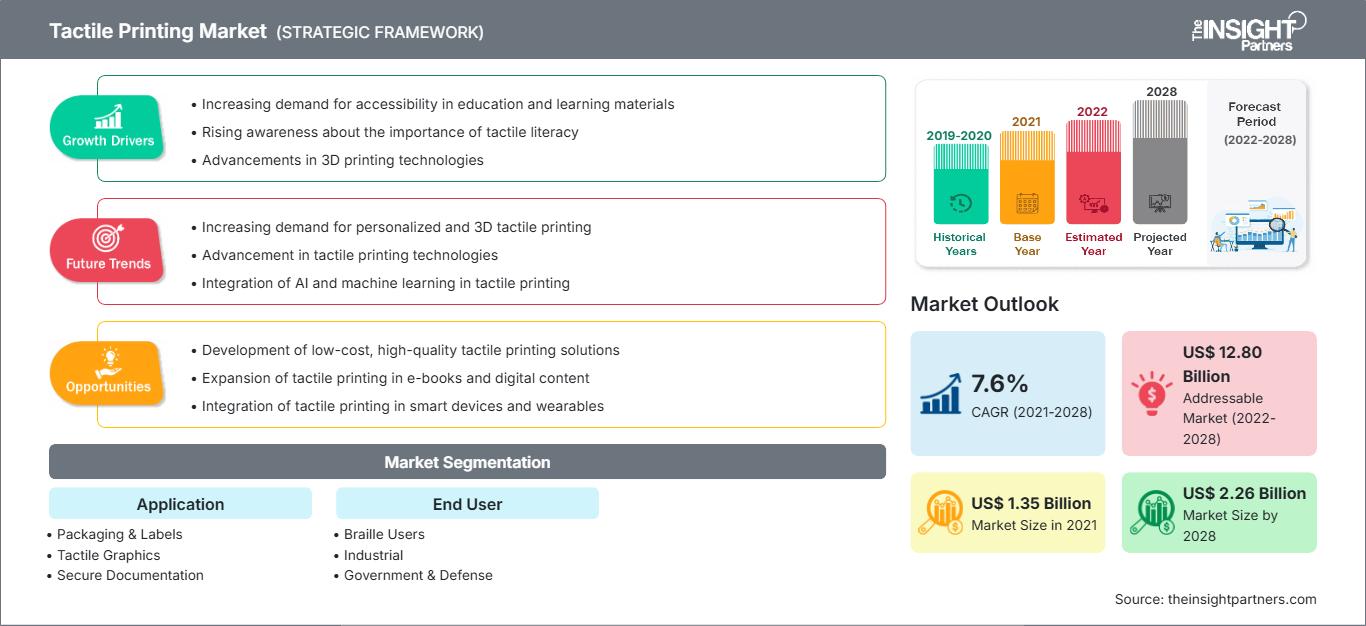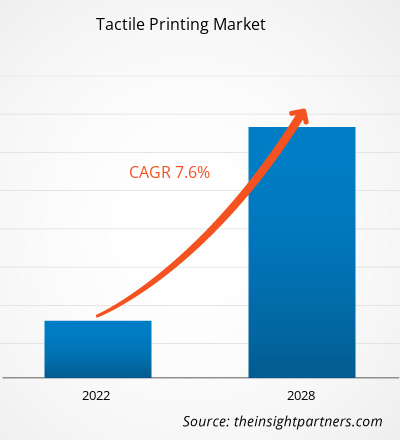触覚印刷市場は2021年に13億5,327万米ドルと評価され、2028年には22億5,792万米ドルに達すると予測されています。2021年から2028年にかけて年平均成長率(CAGR)7.6%で成長すると見込まれています。
触覚印刷とは、印刷対象物に触覚で感知できるテクスチャを作成するプロセスです。触覚印刷は、医薬品、医療用包装、福祉サービス、健康科学、農業、サービスなどの分野で様々な用途があります。触覚印刷の需要は、主にマッピング、ラベリング、包装、セキュリティ、および安全な文書作成におけるこの技術の使用増加によって推進されています。さらに、点字印刷ゲーム、リストバンド、ミュージックカード、ピン、スイッチ、名刺、位置情報ラベル、ステッカー、グリーティングカード、電卓といったカスタマイズソリューションの需要の高まりにより、点字印刷技術への投資が増加しており、触覚印刷市場の成長を加速させています。多くの国が視覚障害者の雇用促進に注力していることから、点字印刷業界は触覚印刷市場のプレーヤーにとって大きなビジネスチャンスをもたらしています。
要件に合わせてレポートをカスタマイズ
レポートの一部、国レベルの分析、Excelデータパックなどを含め、スタートアップ&大学向けに特別オファーや割引もご利用いただけます(無償)
触覚印刷市場: 戦略的洞察

-
このレポートの主要な市場動向を入手してください。この無料サンプルには、市場動向から見積もりや予測に至るまでのデータ分析が含まれます。
バリューチェーン全体の需給混乱により、世界の触覚印刷市場で事業を展開する企業は、収益と事業成長の減少に直面しています。そのため、このパンデミックは2020年の市場全体の成長をある程度抑制しました。しかし、世界中の商業および産業ユーザーからの需要の増加が予想されるため、市場の成長は2021年第3四半期から正常化し、2021年から2028年にかけて安定した成長を続けると予想されています。
触覚印刷市場の洞察:視覚障害者を支援する触覚グラフィックスの需要増加
中小企業の雇用主は、多様な候補者に雇用機会を提供し、労働力の中で身体に障害のある候補者を受け入れています。その結果、マーケティング、経営管理、人材サービス、健康科学、農業などの分野で、視覚障害者の求職者が大規模に雇用されています。視覚障害者を雇用している他の分野には、非営利団体、地方自治体、州政府、連邦政府、自営業者などがあります。法改正や公民権法も、視覚障害者のキャリア機会にプラスの影響を与えています。そのため、職場でこれらの人々を支援するための触覚標識板や地図の需要が高まっています。
アプリケーションベースの市場分析
アプリケーションに基づいて、触覚印刷市場は、パッケージとラベル、触覚グラフィックス、および安全な文書に分類されます。2020年には、パッケージとラベルのセグメントが市場をリードしました。触覚印刷は、さまざまな垂直分野のパッケージングとラベリング業務で主要な用途があり、企業がより幅広い顧客基盤を獲得するのに役立ちます。触覚印刷された包装材やラベルも、視覚障害者を支援します。さらに、触覚印刷の使用は、ブランドがパッケージにトレンディなプレゼンテーションや装飾を施し、バリア機能などの特別な機能を提供するのに役立ちます。
触覚印刷
市場で活動する企業は、合併、買収、市場開拓などの戦略を採用することで、市場での地位を維持しています。主要企業による開発事例をいくつかご紹介します。- 2020年、ViewPlus Technologies Inc.は、現在販売されているPower-Dot Brailleで、美しい丸みを帯びた点の形状を維持しながら、デスクトップ点字プリンターの中で最も強力で読みやすい点字を発表しました。 VP Delta 2 と VP Columbia 2 は、高解像度の触覚グラフィックと米国議会図書館 (LOC) 点字をエンボス加工できます。
- 2021 年、Roland DGA Corporation は、ラベル、パッケージ、看板、ディスプレイ、室内装飾品の生産を新たなレベルに引き上げるために独自に設計された次世代 UV プリンター/カッター、VersaUV LEC2-640 と LEC2-330 の発売を発表しました。
触覚印刷市場
予測期間を通じて触覚印刷市場に影響を与える地域的な傾向と要因については、The Insight Partnersのアナリストが詳細に解説しています。このセクションでは、北米、ヨーロッパ、アジア太平洋、中東・アフリカ、中南米における触覚印刷市場のセグメントと地域についても解説します。
触覚印刷市場レポートの範囲
| レポート属性 | 詳細 |
|---|---|
| の市場規模 2021 | US$ 1.35 Billion |
| 市場規模別 2028 | US$ 2.26 Billion |
| 世界的なCAGR (2021 - 2028) | 7.6% |
| 過去データ | 2019-2020 |
| 予測期間 | 2022-2028 |
| 対象セグメント |
By アプリケーション
|
| 対象地域と国 |
北米
|
| 市場リーダーと主要企業の概要 |
|
触覚印刷市場のプレーヤーの密度:ビジネスダイナミクスへの影響を理解する
触覚印刷市場は、消費者の嗜好の変化、技術の進歩、製品の利点に対する認知度の高まりといった要因によるエンドユーザーの需要増加に牽引され、急速に成長しています。需要の増加に伴い、企業は製品ラインナップの拡充、消費者ニーズへの対応のためのイノベーション、そして新たなトレンドの活用を進めており、これが市場の成長をさらに加速させています。

- 入手 触覚印刷市場 主要プレーヤーの概要
- パッケージングとラベル
- 触覚グラフィックス
- 安全な文書化
触覚印刷市場 - エンドユーザー別
- 点字ユーザー
- 産業
- 政府および防衛
触覚印刷市場 -地理別
-
北アメリカ
- 米国
- カナダ
- メキシコ
-
欧州
- ドイツ
- フランス
- イタリア
- 英国
- ロシア
- その他の地域ヨーロッパ
-
アジア太平洋 (APAC)
- オーストラリア
- 中国
- インド
- 日本
- 韓国
- アジア太平洋地域のその他の地域
-
中東およびアフリカ (MEA)
- 南アフリカ
- サウジアラビア
- アラブ首長国連邦
- MEAの残りの部分
-
南アメリカ(SAM)
- ブラジル
- アルゼンチン
- SAM の残りの部分
会社概要
- Altix
- Konica Minolta, Inc.
- Rink Printing Company
- Sturdy Print & Ltd. Design Ltd
- American Thermoform
- Canon Inc
- インデックス点字
- 米国兼松
- ViewPlus Technologies Inc
- ローランド ディー.ジー.株式会社
- 過去2年間の分析、基準年、CAGRによる予測(7年間)
- PEST分析とSWOT分析
- 市場規模価値/数量 - 世界、地域、国
- 業界と競争環境
- Excel データセット
最新レポート
関連レポート
お客様の声
購入理由
- 情報に基づいた意思決定
- 市場動向の理解
- 競合分析
- 顧客インサイト
- 市場予測
- リスク軽減
- 戦略計画
- 投資の正当性
- 新興市場の特定
- マーケティング戦略の強化
- 業務効率の向上
- 規制動向への対応






















 無料サンプルを入手 - 触覚印刷市場
無料サンプルを入手 - 触覚印刷市場